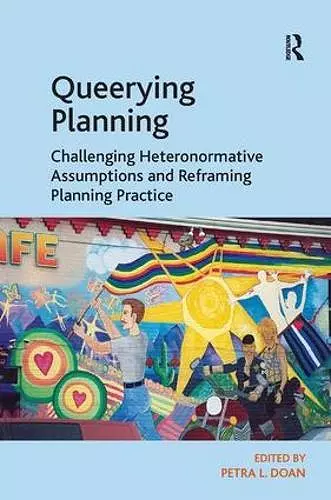Queerying Planning
Challenging Heteronormative Assumptions and Reframing Planning Practice
Format:Hardback
Publisher:Taylor & Francis Ltd
Published:20th Sep '11
Currently unavailable, and unfortunately no date known when it will be back

Current planning practices have largely neglected the needs of the Lesbian, Gay, Bisexual, and Transgender (LGBT) community for safe urban spaces in which to live, work, and play. This volume fills the gap in the literature on the planning and development of queer spaces, and highlights some of the resistance within the planning profession to incorporate gay and lesbian concerns into the planning mainstream. Planning lags behind other disciplines concerned with queer urban issues. In contrast, the field of geography has developed a rich sub-specialty in the geographies of sex and gender that examines spaces and the variety of non-heteronormative populations that inhabit them. This volume brings together both planners and geographers with experience in planning to examine some of the fundamental assumptions of urban planning as they relate to the LGBT community. The first few chapters are substantial revisions and expansions of earlier influential work on planning for non-conformist populations and the preservation of LGBT neighborhoods. Subsequent chapters comprise original contributions that draw on the rich literature from queer theory, planning theory and the geography of sexualities to explore the ways that nonconformist populations struggle with heteronormative expectations embedded in planning theory and procedures. These chapters consider the intersection of planning and a range of populations including transgendered and gender variant individuals. Subsequent chapters examine the ways that variations in the scale of urban and regional governance influence local politics around the implementation of more equitable policies at the city level. In addition, several chapters critically examine the implications of using the tolerance component of Richard Florida's "creative cities" arguments. The final section consists of two chapters that explore the ways that urban planning regimes have been used to regulate sexually-oriented businesses and the way this regulation of sexualized spaces has implications on the heteronormativity of plans and planners. In summary, these chapters interrogate planning practice and pose questions for academic and professional planners about the ways that the queer community and its needs for spaces have shifted. What do those changes mean for the practice of planning 40 years after the North American Stonewall rebellion and looking forward to the next 40 years? To what extent does existing planning practice constrain the evolution of queer communities or seek to commercialize such spaces to...
'Queering Planning is a greatly needed collection of both new and influential literature on queer issues in planning. It is an essential source for planning academics who study LGBT issues and an inspiration for practitioners who seek a deeper understanding of diversity, inclusion and justice in planning. It captures the evolution of the planning profession at a key moment that enlightens about the behavior of professions.' Curt Winkle, University of Illinois at Chicago, USA
ISBN: 9781409428152
Dimensions: unknown
Weight: 657g
294 pages